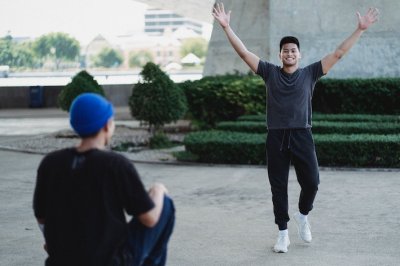The Power of Body Language to Change Your Mood
 by Andrea M. Darcy
by Andrea M. Darcy
A smile comes after we feel happy, and a frown comes after we are sad – or does it? What if it’s sometimes the other way around? Research is increasingly finding that the body language isn’t a one way street. And you can even use it to change your mood.
5 Ways to use body language to change your mood
Don’t believe it? Give the following a try.
1. Sit up straight.
A study at the University of Aukland looked at whether sitting slumped versus sitting up straight could effect responses to stress. Participants were actually taped into chairs to ensure their posture remained consistent! And were then asked to carry out a reading test as their heart rates and blood pressure was monitored.
The results? Those who were sitting with good posture reported greater self-esteem and better moods then those who slumped. Slumpers were found to use more negative words when speaking. And they also used more first person pronouns, leading researchers to conclude that sitting upright causes more self-focus. And when we are stressed, self-focus inevitably means more self-criticism and less confidence.
So sit up straight, you’ll feel better about yourself!
2. Strike a pose.
If you haven’t yet seen the TED talk with social psychologist Amy Cuddy explaining how body language affects our self-perception and behaviour, you should.
Cuddy’s extensive research proved that even a few minutes of ‘faking’ body postures that we connect with power and dominating changes our hormones. Testosterone raises as much as twenty per cent, meaning we are more daring. At the same time cortisol, the stress hormone, lowers as much as twenty-five percent. The result of such ‘power poses’? Better confidence and performance, whether it’s an interview or a presentation you are facing.
A ‘power pose’ involves making yourself bigger, such as opening your shoulders, putting your hands on your hips or behind your head, or if you have a private space available spending a few minutes with your arms flung open or walking up and down with your arms swinging.
Need a quick short cut? Try a quick fist pump in the air when nobody is looking, a classic winner’s move that will raise your confidence.
3. Do your happy walk.

photo by Allan Mas for Pexels
It’s been shown that the way we walk can make us feel happier or more low.
A study at Queen’s University in Canada found that having subjects read either positive or negative words before walking on a treadmill affected their walk. A result they expected.
But the study also found that if encouraged to walk in a depressed style, participants would remember more negative words. But if encouraged to walk in a positive style, would remember more positive words.
The American Institute of Body Language, perhaps taking off from Amy Cuddy’s research, suggests that walking with slumped shoulders releases cortisol and increases stress. Whereas walking with arms swinging and as if you are kicking something along raises testosterone and confidence.
4. Drop your shoulders.
Your shoulders are one of the most common places to hold stress. By focusing on releasing tension in your shoulders, you can apparently improve the flow of blood and oxygen to the brain, making you feel more relaxed and clearer headed. You might also feel the rest of your body following suit and relaxing.
Or, take a cue from progressive muscle relaxation, a tool used by some psychotherapists to help clients manage stress. Tense your shoulders first and hold, then release. It provides a deeper relaxation, and you can go through all your major muscle groups for greater affect.
4. Smile like you mean it.
It was actually Darwin himself who first noted that the main facial muscle used in smiling is connected to positive emotional experience.
But the modern guru on smiling is Paul Ekman, who spent a decade creating a fine tuned system of facial measurement. His comprehensive study of the affects of different ways of smiling on our psychology led him to conclude that-
A really full smile, that uses not just the lips but causes the skin around the eyes to move, can produce brain activation patterns of positive emotions.
This is called the “Duchenne smile”, after a 19th Century French neurologist who recognised that only one smile affected moods.
So don’t just smile, smile so much your eyes crinkle!
And while you are at it, don’t just breathe, belly breathe.
We all, obviously, breathe. But how well are you breathing? It turns out that many of us get by on a sort of half breath, only inhaling into our chests. But, as any singing or acting teacher will chastise you about, true breathing must go into the diaphragm (a large dome shaped organ at the bottom of the rib cage).
In other words, your yoga teacher encouraging you to breathe into your belly is actually encouraging you to breathe properly and fully. Given that breathing improves oxygen flow to the blood and is actually is a way the body expels waste product and that deep breathing not only reduces tension but also anxiety, it’s worth giving it a bit of belly.
Not sure you are doing it right? Put one hand just beneath your ribs, at the top of your stomach, and the other on your chest. Aim for the hand on the belly to visibly rise as you breathe in, while the hand on the chest stays relatively still. As you breathe out, aim for the hand on the belly to visibly fall back, so that you are breathing in and out in equal measure.
Body language is a way forward
This isn’t to suggest that the power of body language can solve the years of learned patterning and experiences that anxiety and depression are based on. But it’s certainly fascinating to remember that we are not just our mind, or our body, or our emotions, but an integrated whole. How can you work more with all that you are to become more of what you want to be?
Photos by Powerhouse museum, Adam Rosenburg, Kenny Louie
 Andrea M. Darcy is a mental health and wellbeing expert and writer. She also runs a consultancy helping people find their perfect therapy and therapist. She’s a huge fan of body language since studying it fifteen years ago. Follow her on Instagram for useful life tips @am_darcy
Andrea M. Darcy is a mental health and wellbeing expert and writer. She also runs a consultancy helping people find their perfect therapy and therapist. She’s a huge fan of body language since studying it fifteen years ago. Follow her on Instagram for useful life tips @am_darcy




